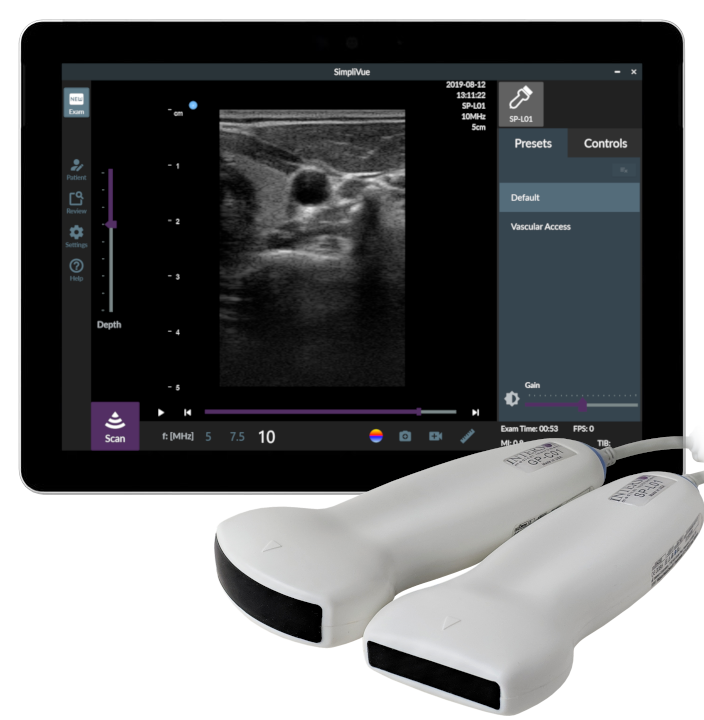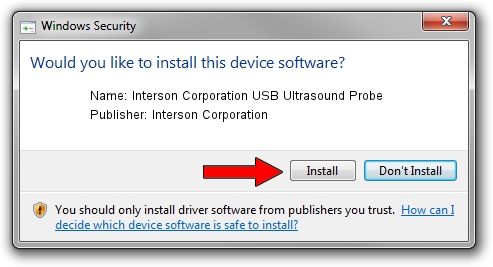Drivers Interson
- Below is a list of drivers and software available for download. GlobalMed recommends disabling antivirus software prior to installation.
- Installation Requires SDK provided by Interson for compilation and USB drivers provided by Interson for running (otherwise Plus application will not start due to missing WDAPI1010.dll). Limitations: imaging parameters are hardcoded, makeing them configurable is a work in progress, see details in #866, #867 and #868.
Congratulations on your purchase of the Interson USB Ultrasound Imaging Probe, the ultrasound imaging probe that plugs into the USB port of your computer. Please review this user guide before you begin scanning. Contact Interson or your sales representative if you have any questions. Note: There is also an on-line Help guide that. Supported hardware devices. This device is used for image acquisition from Interson USB ultrasound systems with SeeMore probes with the.NET (new) interface. Probes with old C interface should be used with Interson USB ultrasound systems (old SDK).
Up:14. Distributing Your Driver Previous:14.1 Getting a ValidContentsSubsections****************************************************************************************
| NOTES |
|
Distributing the driver you created is a multi-step process. First, create adistribution package that includes all the files required for the installationof the driver on the target computer. Second, install the driver on the targetmachine. This involves installing windrvr6.sys andwindrvr6.inf,installing the specific INF file for your device (for Plug-and-Play hardware - PCI/PCI Express/PCMCIA), and installing your KernelPlugIn driver (if you have created one).Finally, you need to install and execute the hardware control application thatyou developed with WinDriver. These steps can be performed usingwdreg utility.
****************************************************************************************| NOTE |
| This section refers to distribution of *.sys files. Startingfrom WinDriver version 6.21 *.vxd drivers are no longer supported. |
14.2.1 Preparing the Distribution Package
Your distribution package should include the following files:
- Your hardware control application/DLL.
- windrvr6.sys.Get this file from the WinDriverredist directory inthe WinDriver package.
- windrvr6.inf.Get this file from the WinDriverredist directory inthe WinDriver package.
- wd1010.cat.Get this file from the WinDriverredist directory inthe WinDriver package.
- wdapi1010.dll (for distribution of32-bit binaries to 32-bit target platforms or for distribution of 64-bitbinaries to 64-bit platforms) or wdapi1010_32.dll(for distribution of 32-bit binaries to 64-bit platforms [A.2]).Get this file from the WinDriverredist directory inthe WinDriver package.
- difxapi.dll (required by thewdreg.exe utility [13.2.2]).
Get this file from the WinDriverutil directory in theWinDriver package. - An INF file for your device (required for Plug-and-Play devices, such as PCI and PCMCIA).
You can generate this file with the DriverWizard, as explained insection 4.2. - Your Kernel PlugIn driver - <KP driver name>.sys -if you have created such a driver.
14.2.2 Installing Your Driver on the Target Computer
****************************************************************************************| NOTE |
| Driver installation on Windows requires administrator privileges. |
Follow the instructions below in the order specified to properly install yourdriver on the target computer:



- Preliminary Steps:
- To successfully install your driver, make sure that there are no open handles tothe WinDriver service (windrvr6.sys or your renamed driver [15.2]), and that there are no connected and enabledPlug-and-Play devices that are registered with this service. This is relevant, forexample, when upgrading the version of the driver (for WinDriverv6.0.0 and above; earlier versions used a different module name).If the service is being used, attempts to install the new driverusing wdreg will fail.
You can disable or uninstall connected devices from the DeviceManager (Properties | Disable / Uninstall) or usingwdreg, or otherwise physically disconnect thedevice(s) from the PC. - On Windows 2000, remove any INF file(s) previouslyinstalled for yourPlug-and-Playdevice (such as files created with an earlier version of WinDriver)from the %windir%inf directory before installingthe new INF file that you created for the device. This will preventWindows from automatically detecting and installing an obsoletefile. You can search the INF directory for the device's vendor IDand device/product ID to locate the file(s) associated with thedevice.
- To successfully install your driver, make sure that there are no open handles tothe WinDriver service (windrvr6.sys or your renamed driver [15.2]), and that there are no connected and enabledPlug-and-Play devices that are registered with this service. This is relevant, forexample, when upgrading the version of the driver (for WinDriverv6.0.0 and above; earlier versions used a different module name).If the service is being used, attempts to install the new driverusing wdreg will fail.
- Install WinDriver's kernel module:
- Copy windrvr6.sys,windrvr6.inf and wd1010.catto the same directory.
****************************************************************************************
****************************************************************************************NOTE wd1010.cat contains the driver'sAuthenticode digital signature. To maintain the signature'svalidity this file must be found in the same installation directoryas the windrvr6.inf file. If you select todistribute the catalog and INF files in different directories, ormake any changes to these files or to any other files referred toby the catalog file (such as windrvr6.sys), youwill need to do either of the following: - Create a new catalog file and re-sign the driver usingthis file.
- Comment-out or remove the following line in thewindrvr6.inf file:
CatalogFile=wd1010.cat
and do not include the catalog file in your driverdistribution. However, note that this option invalidates thedriver's digital signature.
- Use the utility wdreg to install WinDriver'skernel module on the target computer:
wdreg -inf <path to windrvr6.inf> installFor example, if windrvr6.inf andwindrvr6.sys are in the d:MyDevice directory on the target computer, the command shouldbe:
wdreg -inf d:MyDevicewindrvr6.inf installYou can find the executable of wdreg in theWinDriver package under the WinDriverutildirectory. For a general description of this utility and itsusage, please refer to Chapter 13.
****************************************************************************************
****************************************************************************************NOTES - wdreg is dependent on thedifxapi.dll DLL.
- wdreg is an interactive utility. If itfails, it will display a message instructing the user how toovercome the problem. In some cases the user may be asked toreboot the computer.
****************************************************************************************
****************************************************************************************CAUTION! When distributing your driver, take care not to overwrite a newerversion of windrvr6.sys with an older version ofthe file in Windows drivers directory (%windir%system32drivers). You should configure your installationprogram (if you are using one) or your INF file so that theinstaller automatically compares the time stamp on these two filesand does not overwrite a newer version with an older one.
- Copy windrvr6.sys,windrvr6.inf and wd1010.catto the same directory.
- Install the INF file for your device (registering yourPlug-and-Play device with windrvr6.sys):
Run the utility wdreg with the install command toautomatically install the INF file and update Windows Device Manager:
wdreg -inf <path to your INF file> installYou can also use the wdreg utility's preinstallcommand to pre-install an INF file for a device that is not currentlyconnected to the PC:
wdreg -inf <path to your INF file> preinstall****************************************************************************************
****************************************************************************************NOTE On Windows 2000, if another INF file was previously installedfor the device, which registered the device to work with thePlug-and-Play driver used in earlier versions of WinDriver remove anyINF file(s) for the device from the %windir%infdirectory before installing the new INF file that you created. This willprevent Windows from automatically detecting and installing an obsoletefile. You can search the INF directory for the device's vendor ID anddevice/product ID to locate the file(s) associated with the device. - Install your Kernel PlugIn driver: If you have created aKernel PlugIn driver, install it by following the instructions insection 14.2.3.
- Install wdapi1010.dll:
If your hardware control application/DLL useswdapi1010.dll (as is the case for the sample andgenerated DriverWizard WinDriver projects), copy this DLL to the target's%windir%system32 directory.If you are distributing a 32-bit application/DLL to a target 64-bitplatform [A.2], renamewdapi1010_32.dll in your distribution package towdapi1010.dll, and copy the renamed file to thetarget's %windir%sysWOW64 directory.****************************************************************************************
****************************************************************************************NOTE If you attempt to write a 32-bit installation program that installs a64-bit program, and therefore copies the 64-bitwdapi1010.dll DLL to the%windir%system32 directory, you may find that thefile is actually copied to the 32-bit%windir%sysWOW64 directory. The reason for this isthat Windows x64 platforms translate references to 64-bit directoriesfrom 32-bit commands into references to 32-bit directories. You can avoidthe problem by using 64-bit commands to perform the necessaryinstallation steps from your 32-bit installation program. Thesystem64.exe program, provided in theWinDriverredist directory of the Windows x64 WinDriver distributions,enables you to do this. - Install your hardware control application/DLL: Copy yourhardware control application/DLL to the target and run it!
14.2.3 Installing Your Kernel PlugIn on the Target Computer
****************************************************************************************
| NOTE |
| Driver installation on Windows requires administrator privileges. |
If you have created a Kernel PlugIn driver, follow the additionalinstructions below:
- Copy your Kernel PlugIn driver (<KP driver name>.sys) to Windows drivers directory on the targetcomputer (%windir%system32drivers).
- Use the utility wdreg to add your Kernel PlugIndriver to the list of device drivers Windows loads on boot. Use thefollowing installation command:
To install a SYS Kernel PlugIn Driver:
wdreg -name <Your driver name, without the *.sysextension> installYou can find the executable of wdreg in the WinDriverpackage under the WinDriverutil directory. For ageneral description of this utility and its usage, please refer toChapter 13 (see specificallysection 13.2.4 for Kernel PlugIn installation).
Next:14.3 Windows CE Driver Up:14. Distributing Your Driver Previous:14.1 Getting a Valid
Drivers Intervention Program Cleveland Ohio
Contents